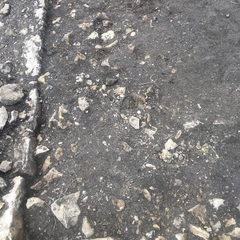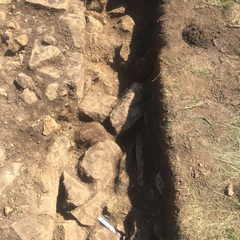Basic Information
- Demolition spread over and within large building
Narrative
-
- A spread of demolition material from the building defined by the walls (1002), (1003) and curtain wall (1008). This spread comprised rubble located both outside of the structure (1005) and within the structure (1004). The rubble was observed as a spread outside of the structure and a more defined concentration within the interior.
-
- Chris Scott
- 28-8-2019
-
- Demolition and abandonment debris F13 helped to further characterise structure F14. On the interior of building, debris contained glazed tile (SF18), stone floor tile (SF38), a column drum fragment (SF35), and fragments of mortar with white paint revealing evidence of internal decoration. The occurrence of glazed tile may indicate an ecclesiastical structure and it is possible that some of the CBM fragments were ridge tile, also commonly associated with early ecclesiastical structures and perhaps indicative of a chapel.
-
- Indie Jago
- 16-10-2020
Dating Narrative
-
- Numerous pottery fragments from a wide range of different wares and vessel types were recovered from debris F13, including local wares (types 1, 3, 4, 5, 6 and 7; including SF8, SF9, SF10, SF12, SF15, SF41 and SF43), coal measures whiteware, Healey types ware (including SF45), Humberware (including SF7, SF8, SF13, SF14, SF21, SF22, SF25, and SF37), NGR type ware, and Tees Valley ware (type B; including SF32). Much of the pottery assemblage was likely residual as attested by refits between potsherds recovered from earlier layers (1006), (1011) and (1017). However, Early Healy type wares were only recovered from the demolition and abandonment debris F13 and provide a likely terminus anti quem for the demolition event of AD1450-1600 AD.
-
- Indie Jago
- 16-10-2020


